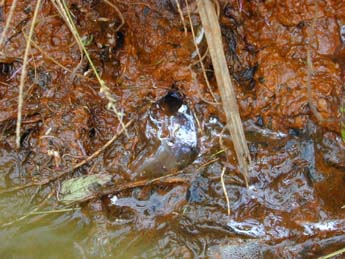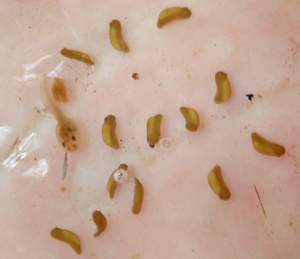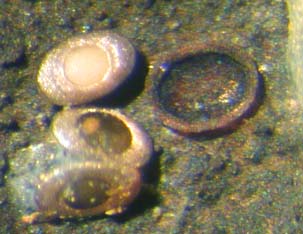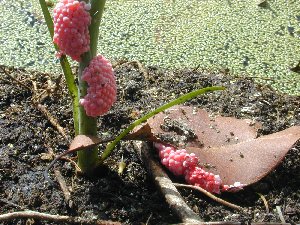|
|
Key to Aquatic Organisms and Features: Plants, Rocks, and Oddities
in the Hawaiian Islands
|
|
|
|
[PLANT or ANIMAL ?]
|
|
2a
|
(1) |
Specimen is pretty obviously a plant with green pigment (chlorophyll).
{ Thallus (the plant body) growing attached or floating. Thallus is
either a crust or a mass, or thallus is filamentous (hair-like, and
branching or not); OR specimen is a plant with leaves, roots and/or stems
|
[24 ] ]
|
|
|
2b
|
|
Specimen lacks green pigment OR appears to, OR specimen is not a live plant or animal { Color is either black, brown, tan, red, pink, orange, gray, yellow, white, or mostly transparent OR if non-living, any of these or green.
|
[3] |
|
|
|
|
~~~~~~~~~~~~~~~~~~~~~~~~~~~~~
|
|
3a
|
(2) |
Specimen is or appears to be a living organism
|
[4]
|
|
3b
|
|
Specimen is or appears to be mineral { either a rock, rock formation, sediment, or soil OR a skeleton of a once-living organism
|
[16] |
|
|
|
|
~~~~~~~~~~~~~~~~~~~~~~~~~~~~~
|
|
4a
|
(3) |
Form is either a gelatinous mass (firm or soft), a gelatinous egg mass, a smooth crust, or form is more or less thread like (filamentous; branching or not). Color is gray to black or dark blue-green; OR color is olive, brown, tan, orange, red, or mostly transparent
|
[5]
|
|
4b
|
|
Form is a hispid (covered with stiff points or hairs) crust or mass, OR is branching, but not filamentous; OR form is a distinct shape and appears to be an egg, mass of eggs, or a case. Color usually light yellow, light tan, or white, without blue or blue-green
|
[10] |
|
|
|
|
~~~~~~~~~~~~~~~~~~~~~~~~~~~~~
|
|
5a
|
(4) |
Form a weak or strong gelatinous mass or gelatinous string, may contain egg-like units or not
|
[6]
|
|
5b
|
|
Not gelatinous. Form either a thin crust, or more or less thread-like (branching or not), or a non-gelatinous mass of egg-like units
|
[8] |
|
|
|
|
~~~~~~~~~~~~~~~~~~~~~~~~~~~~~
|
|


|
|
Figure 1 (left). Close-up of mud seep with growth of rust colored iron bacteria. Note the oil-like sheen (center and lower right) of bacteria
waste floating on wet surface.
Figure 2 (right). Embryos of the frog, Glandriana rugosa, still in a clear, gelatinous envelope
(note tadpole).
|
|
6a
|
(5) |
Color orange-brown (rust-colored) or light brown or pinkish. Form macroscopically amorphous (without any evident structure): diffuse floc or gelatinous to flocculent "slime" in water or forming rust-colored stains and slimes on banks around seeps (Fig. 1, above). Microscopically seen to consist of thin (~1 micron) filaments mostly less than 0.2 mm long. Iron bacteria
|
[Note D]
|
|
6b
|
|
Color not like rust. Form either a solid mass of some other color; OR if soft and gelatinous, then with white or dark egg-like structures embedded in the gelatinous material (Fig.2)
|
[7] |
|
|
|
|
~~~~~~~~~~~~~~~~~~~~~~~~~~~~~
|
|
[NOTE THREE CHOICES HERE]
|
|
7a
|
(6) |
Gelatinous mass suffused with color: either red, brown, green, or some shade of green or brown, or very dark
|
[33 ] ]
|
|
7b
|
|
Mass a small, clear gelatinous body with nearly microscopic, round white bodies (eggs or embryos). Molluscan (snail) eggs
|
|
|
|
7c
|
|
Gelatinous material clear, holding macroscopic, round or slightly elongated dark bodies (eggs or embryos; Fig. 2). Amphibian eggs
|
[40 ] ] |
|
|
|
|
~~~~~~~~~~~~~~~~~~~~~~~~~~~~~
|
|
8a
|
(5) |
Form is egg-shaped or a cluster of egg-like units
|
[12]
|
|
8b
|
|
Form either a thin crust, or thread-like and branching
|
[9] |
|
|
|
|
~~~~~~~~~~~~~~~~~~~~~~~~~~~~~
|
|
9a
|
(8) |
Form is a crust; OR, if thread-like, then microscopically seen to be a chain of cells only one or a few cells thick
|
[30 ] ]
|
|
9b
|
|
Form is a branching colony of intimately connected individuals, not a chain of cells
~ Phylum BRYOZOA
|
[38 ] ] |
|
|


|
|
Figure 3 (left). Statoblasts (?floatoblasts) of a bryozoan (Plumatella sp.) on the underside of a rock. Each asexually produced resting stage is about 0.3 mm long. On the right is the attachment portion of a released sessoblast.
Figure 4 (right). Egg masses of an applesnail are laid above the water surface.
|
|
|
|
~~~~~~~~~~~~~~~~~~~~~~~~~~~~~
|
|
10a
|
(4) |
Form is a mass, or egg-like, or a cluster of egg-like units; OR form is a case of some kind. (Fig. 3 shows statoblasts of a bryzoan)
|
[11]
|
|
10b
|
|
Form is a branching colony of intimately connected individuals
~ Phylum BRYOZOA
|
[38] |
|
|
|
|
~~~~~~~~~~~~~~~~~~~~~~~~~~~~~
|
|
11a
|
(10) |
Form is egg-shaped or a mass composed of egg-shaped objects
|
[12]
|
|
11b
|
|
Form is not egg-shaped but some other shape; if a mass, then not a mass of egg-shaped pieces
|
[13] |
|
|
|
|
~~~~~~~~~~~~~~~~~~~~~~~~~~~~~
|
|
12a |
(8)&
(11) |
Eggs about 3 mm in diameter, arranged in an elongated mass attached to vegetation or other objects above the water line of relatively still waters (ponds, lo`i, drainage ditches). Having a white, calcareous shell, but contents (and overall color if fresh) is salmon red. Applesnail egg mass
~ Phylum MOLLUSCA ~ Class GASTROPODA ~ Family PILIDAE
~ Pomacea sp.
|
|
12b
|
|
Eggs smaller, or if similar size, then not pink or red in color
|
[14] |
|
|
|
|
~~~~~~~~~~~~~~~~~~~~~~~~~~~~~
|
|
13a
|
(11) |
Whitish, papery, cylindrical or urn-shaped to 4 mm across, attached at base to submerged vegetation; upper end with circular cover extended at one edge into long narrow piece reaching to or towards water surface. egg case
~ Class INSECTA ~ Family HYDROPHILIDAE
|
|
|
13b
|
|
Shape or form is otherwise
|
[14] |
|
|
|
|
~~~~~~~~~~~~~~~~~~~~~~~~~~~~~
|
|
14a |
(12) & (13) |
 Mass a yellowish to light tan encrusting growth with numerous voids (sponge-like). Mass with or without a layer of many, small (about 1/3 mm) yellow spheres (Fig. 4). Sponge
Mass a yellowish to light tan encrusting growth with numerous voids (sponge-like). Mass with or without a layer of many, small (about 1/3 mm) yellow spheres (Fig. 4). Sponge
~ ~ Phylum PORIFERA ~ Family SPONGILLIDAE
Heteromyenia baileyi (Bowerbank)
Figure 5. A freshwater sponge growing as an encrusting mass over a rock surface. Note hispid surface and deep layer of yellowish egg-like structures called gemmules in lower quarter of photo.
|
|
14b
|
|
Shape or form is otherwise
|
[100] |
|